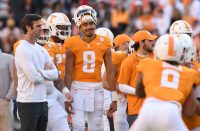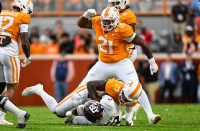Yesterday, we showed how and why bigger is better along the defensive front. It’s true. Size matters, at least for defensive tackles, ends, and linebackers. It means the offense can’t push you around; they have to go around you to the locations of your choosing. It means the defensive backs can do their jobs first instead of making themselves vulnerable by overhelping in run support. It gets offenses off schedule, forcing them into difficult down-and-distance situations.
It’s not absolutely necessary, and it’s absolutely not sufficient, but heft is a significant factor in the competence of a team’s defensive front. As a general rule, you want the cumulative weight of the seven guys closest to the line of scrimmage to be 1,800 pounds or more.
How do the Tennessee Volunteers look by this metric? Pretty good, actually, and it’s getting even better.
The 2017 season: Prior to Pruitt
In 2017, the year before Jeremy Pruitt arrived, Tennessee’s starting defensive front weighed in at 1,817 pounds. At 295, Kendal Vickers wasn’t the biggest guy on the roster, but the fact that he started every game at one of the tackle spots meant he was the best option there. Kahlil McKenzie and Shy Tuttle took turns next to Vickers at the other tackle spot, McKenzie starting eight games and Tuttle starting four. Both of these guys were huge, McKenzie at 320 and Tuttle at 308.
Still operating as a base 4-3 defense, there were two defensive end spots in 2017, and the season’s starters were some combination of Kyle Phillips, Jonathan Kongbo, and Darrell Taylor. Those guys were 263, 264, and 254, respectively. After Cortez McDowell was lost for the season, the starting linebackers were almost exclusively some combination of Quart’e Sapp (222), Daniel Bituli (235), and Colton Jumper (229).
Averaging the weights where necessary for positions occupied at different times by different players, that puts the cumulative defensive front seven weight at 1,817 pounds, just over the 1,800-pound threshold. It’s also squarely in the middle of yesterday’s table listing the Top 20 defenses of 2009 and their cumulative defensive front weights.
As proof that just being big doesn’t make you good, the 2017 team finished only 10th in the SEC and 81st in the nation in total defense. But they were big enough to be good. Put another way, weight wasn’t the problem in 2017, something you probably already suspected.
The 2018 season: Pruitt’s Year 1
Things were already better in Jeremy Pruitt’s very first season, as his first defensive front weighed in at 1,866 pounds. Shy Tuttle had lost a little weight from 2017, but he was still 300 pounds, and he started every game at nose tackle in Pruitt’s 3-4 base defense. Kyle Phillips started every game at one of the defensive end positions, and he’d added ten pounds to his frame to weigh in at 273. The other defensive end position was manned by the massive Alexis Johnson, who was listed at 314 pounds. He started every game as well.
The four linebacker spots were primarily Darrell Taylor and Jonathan Kongbo on the outside and Daniel Bituli and Darrin Kirkland, Jr. on the inside. Taylor and Kongbo had both moved from defensive end to outside linebacker and had both lost some weight for the move, but they were the right size for their new positions. Taylor was 247 and Kongbo was 254. Bituli had gained almost 10 pounds and was at 244, and Kirkland, coming off a medical redshirt, was 234.
That made the front seven 1,866 pounds. If you put them on the 2009 list, they would have been the fourth-heaviest front seven that season, behind only Alabama, Florida, and LSU.
The defense was better that year, too, although still far from where they wanted to be. The finished the season 9th in the SEC and 49th in the nation in total defense. After allowing an average of 412.9 yards per game in 2017, they allowed only 377.4 in 2018. Rushing defense, in particular, improved dramatically. In 2017, the team allowed 251.3 rushing yards per game, putting them dead last in the SEC and 125th in the nation. But last year, they were 9th in the SEC and 52nd in the nation, allowing only 154.5 rushing yards per game.
The upcoming season: Pruitt’s Year 2
It looks like Tennessee’s defensive front seven is growing yet again this year. Due to the graduation of all of last year’s starters on the line and the uncertain status of Kirkland, we can’t know this fall’s starting lineup for sure yet, but making some reasonable assumptions and looking at the roster suggests that the cumulative weight of the starting front seven could creep up to a full 1,889 pounds this season.
Emmitt Gooden is almost certain to start along the defensive line, as he’s the only returning lineman with any starts to his name. He’s currently listed at 302 pounds, which is a good start.
Predicting what the NCAA is going to decide about transfers’ immediate eligibility requests is riskier than picking games against the spread, but if you were betting, you’d put your money on Michigan transfer Aubrey Solomon being eligible to play this fall for the Vols. The former 5-star recruit with experience playing for the Wolverines is walking into a wide-open opportunity on Rocky Top, so if he’s eligible, he’s almost certain to start as well. He’s 306 pounds.
The third lineman is anybody’s guess at this point. The candidates include Kingston Harris (312), Greg Emerson (310), Kurott Garland (303), Matthew Butler (285), and John Mincey (280), but my money is on Savion Williams, who’s a monster at 315 pounds and the nation’s top JUCO recruit at the position this cycle. If the defensive line starters are Gooden, Solomon, and Williams, Tennessee suddenly has three 300-pounders on the line of scrimmage.
Darrell Taylor will man one of the OLB positions, and he’s currently listed at 255 pounds, up eight from last year. Daniel Bituli will be one of the other guys, and he’s listed at 243, essentially the same weight as he was last year.
If Kirkland decides to play this fall instead of using the time to rehab and ready himself for the NFL Draft, he’ll play as well. He’s listed at 225, down even from last season.
If Kirkland does not play, there will be two starting spots at linebacker up for grabs. Here are the guys vying for them (in order of weight): Kivon Bennett (251), Jordan Allen (249), Quavaris Crouch (242), Deandre Johnson (241), Shanon Reid (230), Henry To’oto’o (230), Will Ignont (229), J.J. Peterson (228), and Solon Page III (220). If I had to guess, I’d say Ignont and Johnson would earn those spots first just based on them having more experience than the others, but I wouldn’t be surprised if it’s someone else. Newcomer Crouch is especially intriguing, as he arrives on campus in a ready-made body.
But if it’s Ignont and Johnson, that would make the cumulative weight of the defensive front seven 1,891 pounds (1,889 if it’s Kirkland instead of Ignont). On that old 2009 list of the Top 20 defenses with their respective weights, Tennessee’s 2019 edition would be the second-heaviest, behind only Alabama.
Does the 2009 benchmark still apply in 2019?
Yes, things may have changed since 2009. Lines may have gotten even bigger. We’ll take a look at that starting next week.
But for now, just know two things: Bigger is better along the defensive front, and Tennessee’s defensive front is getting bigger.



